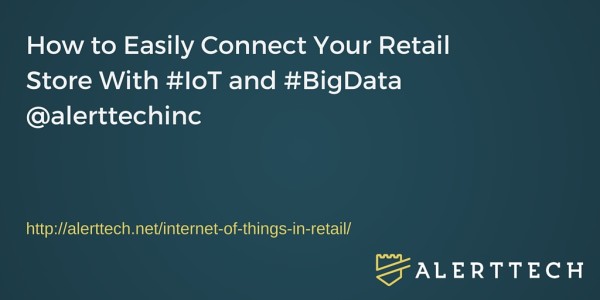You’ve probably heard the terms before. “Internet of Things” and “big data” are often used in conversation about work, home life, and your business. But what do they really mean? More importantly, how can they help you?
Retailers are often overwhelmed by this new technology. Although it sounds enticing on the surface, imagining the implementation of it is a little tricky.
If you’re looking for a simplified explanation of these and other terms specific to your retail business, look no further.
What is IoT?
The Internet of Things (IoT) is the connection of any device to another device or human.
For example, if you’ve ever controlled your store’s thermostat using an app on your smartphone, you’re using IoT. Your smartphone connects to the air conditioner or heater sending a signal about what temperature you’d like your store. Without having to dig behind racks of clothing to find a box on the wall to make adjustments, you can use your cell phone instead.
Another example is fitness trackers. Some retailers are using these to encourage employees to walk more throughout the day. The device is usually a bracelet, and it links up with human activity to track output.
The Internet of Things in retail is extraordinarily powerful. Sensors are the most common type of connection used in retail stores – and for good reason. Let’s take a closer look.
Sensors
Sensors collect data throughout the day, such as foot traffic, bar code scanning, fitting room occupancy, and call buttons.
Data is collected using iBeacons in your store or on your POS system (among other things). Once collected it is shared over a network, such as the Internet, radio, Wifi, RFID, etc. It arrives on another device where you can put it to use to analyze and improve your store.
Related Post: 5 Things You Need to Know About Beacons Technology
The amount of data collected using sensors is substantial. That’s why it’s often referred to as “big data.” With this information, you can make your store more lucrative. Here’s how.
IoT in Retail
When getting started, you must first decide how you want to use IoT in your retail store. Some of the most common use cases include:
- Product tracking and inventory management;
- Customer engagement with a sales representative;
- Shopper intelligence;
- Mobile payment;
- And much, much more.
In this infographic we outline specifically how retailers are using IoT to improve their stores.
When you know what problem you want to solve, you’re better equipped to find the right solution to make it happen. Here are a few examples of how it all comes together.
Push Product Off Your Shelves
Want to get a specific product moving off your shelves? Send your shoppers specific offers using iBeacon technology. When the shopper enters your store, they are instantly met with a great deal making their experience with you feel more personalized and your sales more effective.
[Tweet “Push more product off your shelves with #IoT. #Retail @alerttechinc”]
Improve Customer Engagement
If there is a disconnect between the number of people walking into your store and the number of people buying, it could be a problem of poor customer engagement. Improve it by adding a call button to your fitting rooms. When pushed, a customer is connected to an associate through an iPad app or over a 2-way radio.
[xyz-ihs snippet=”MOFU-Fit-Happens-button”]
Analyze Your Store’s Performance
Ultimately, you can gather all of the data from your front door, fitting room and POS system to monitor your store’s performance. You can do this in real time to see how much store traffic you’re receiving vs. how many people are making it to the cash wrap. Or, you can do this over time to analyze where you’re losing the majority of your customers.
[Tweet “Big data lets you quickly analyze where you’re losing the majority of your customers. @alerttechinc”]
The Gist
IoT and big data sound complicated, but when used together you can quickly gather invaluable data that can be analyzed to improve the performance for your retail store. Get to know your shoppers, engage them on a deeper level, and sell more products by implementing this technology throughout your store. It’s easier than you might think.
[xyz-ihs snippet=”TOFU-Retail-Analytics-IOT”]

